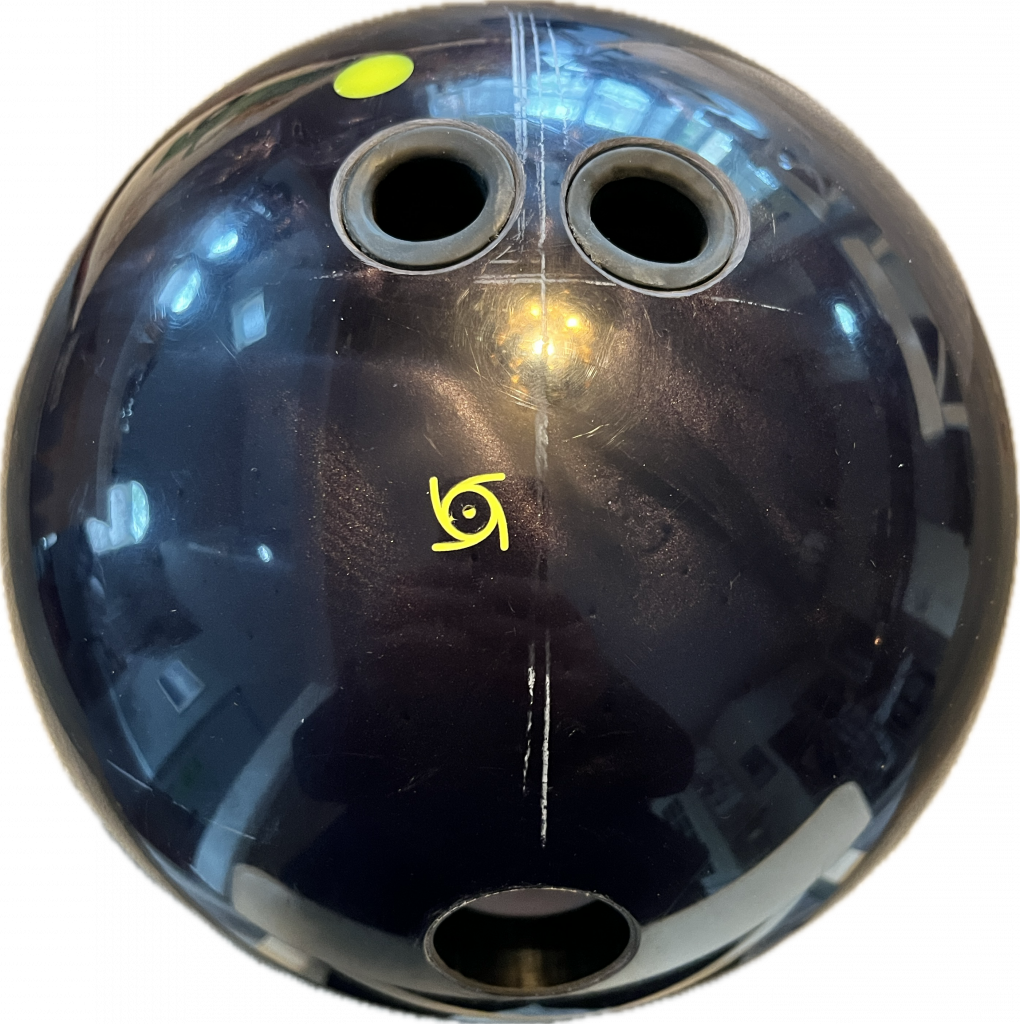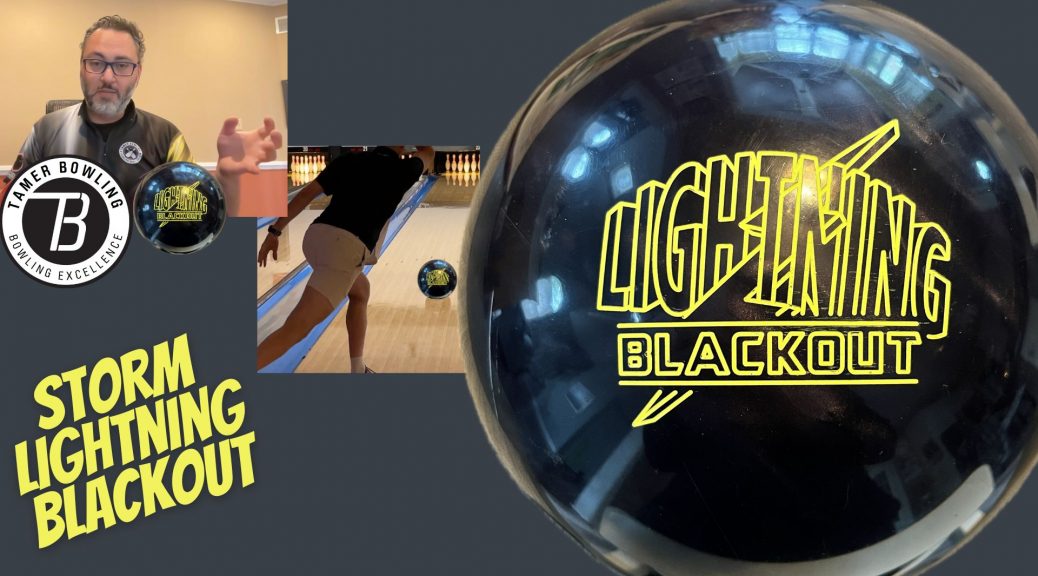

First Impressions
The Storm Lightning Blackout feels more than it should be until it doesn’t.
Tamer Elbaga (Lefty)
Style: Tweener
RPM: 330 rpm
PAP: 5 & 3/8 up
Average Speed: 18.5 mph (at release)
Axis tilt: low
Axis rotation: medium/high
Test Equipment: 14 Pounds
Layout: 4 x 35
Bryan Hoffman (Righty)
Style: Stroker
RPM: 280 rpm
PAP: 4 1/2 & 1 1/2 up
Average Speed: 18.5 mph (at release)
Axis tilt: high
Axis rotation: medium
Test Equipment: 14 Pounds
Layout: 5 x 40
Tyler Church (Righty)
Style: Power Player
RPM: 450 rpm
PAP: 5 1/2 & 1/2 up
Average Speed: 19 mph (at release)
Axis tilt: med
Axis rotation: medium
Test Equipment: 14 Pounds
Layout: 5 x 45
“Keep in mind that coverstock accounts for 70% of ball reaction, but the core creates the dynamic shape of the reaction. Your driller will alter the shape to suit your game.”
Pattern
THS: 42ft, 23ml
Sport: TBD
Specs
The Storm Blackout Lightning uses the Warp AI symmetric core inside the ReX Pearl coverstock.
15 pound = RG of 2.53 diff of .029
14 pound = RG of 2.55, diff of .029
Coverstock finish: Reactagloss
Overall
The first thoughts from some was nostalgia when seeing the label. I recall the old lightning logo as well but I can’t comment on this ball’s relationship to old stuff. But we can evaluate what we saw. The new Lightning Blackout uses now common ReX pearl but has a new Warp AI core. Looking at core shape, the medium RG and low diff immediately had me thinking of the Hustle lineup in some way. So I immediately thought this ball would punch above it’s weight. Then with the reaction, we don’t see Hustles really. The giveaway is the stronger and pretty responsive ReX cover on this ball. I expected a clean ball that is a bit sharper than the IQ Tour Ruby but maybe a little stronger. I’d say it’s a good amount stronger actually. It would appear to theoretically be a stronger ball for those higher volumes when tour players want something clean but still gets around it and at the same time is a step up from a Mid Late ball like the IQ Tour Ruby. So I struggled to keep it left of the head pin for a bit until I opened up enough. Once I opened up enough, I had a look in a small window. Another board or 2 and I struggled to get it to be continuous enough to carry. This perplexed me initially but then it kind of made sense. Stronger cover, “weaker core”. So it looked very strong until it didn’t. Once I opened enough to compensate for the cover, the core was not my friend. I also wasn’t executing as well as I felt boxed in. Prior to throwing it, I would’ve thought this is a Mid Late ball in the arsenal and I brought the Ruby to test alongside. After throwing it, it really borders on mid defined when angles are a little closed and mid late when they are open. That either makes it a chameleon or unusable. The other thing of note is that I feel this combination really seems to make the ball roll way more forward than I anticipated. Now take a look at the Ruby to see a proper mid late ball and the shape is very different. So round and understandable. No surprises, doesn’t have a cliff the way the Lightning Blackout does.
Power Player’s Perspective
Tyler tests the new Storm Lightning Blackout. In short, he saw the same thing I saw on our house shot. This is a relatively clean ball with more strength than expected. However, once you open up enough, it didn’t quite have the strength to hit well. This really may be down to testing on a fresh house shot. This creates a couple of issues for the ball. The ball is too strong to play direct but the pattern is not broken down enough for the ball to work from deeper. This all sounds logical and you might say why not test it on a more conducive situation like breakdown. Well to get apples to apples, we test on the same conditions. We can also clearly see what works when. What we can say for certain is the Lightning Blackout is not a ball for fresh out of box and I believe it will work better with a more tapered shot. The ball seems to have a bit of a hook set nature once the you have to open up the lanes. I think part of that is that the cover is a bit stronger than the core. So once the cover is given enough room, the core is on the weaker side. I thought it would look better for Tyler as he has a higher rev rate to counteract the weaker core. However, his look was just like mine surprisingly. While Tyler and I both love our IQ Tour Ruby which also has a lower diff core, it seems the stronger ReX cover with that type of core has significantly changed the formula.
Now we also added a surface adjustment portion to this video as we have done with the Storm The Road. The first adjustment is a light scuff with 3000 to get a little edge into the lane shined/ReactaGloss finish. You can it has a bit more consistent traction for Tyler but still about the same look. For me, here’s a baseline since I don’t like Reactagloss anyway. You can see how strong the ball turns over if you are a little too direct.
Next is more proper 3000 by hand and you can see it gets a little rounder, very tiny move for me. For Tyler this change really locked him up. It’s now too strong from where he was but the surface seemed to significantly calm the backend that the small adjustment he needed just would make the ball hit extremely weak.
We swiftly move to 1500 by hand and that really brought the ball into a beautiful window for Tyler. Now it seemed to push him in but at the same time create enough traction to get the ball started perfectly. Just shows you how critical surface finish can be to fine tune a ball reaction. For me on the other hand, it seemed to weaken the backend just enough to where I left corner pins and had to play around with speed to get the ball to drive properly.
Moving on to 500 seemed to do for me what 1500 did for Tyler. Now the surface pushed me deeper but the ball started sooner and drove better. Even when it was a deflecting type shot, I carried better. For Tyler this is just too chuggy and doesn’t work well.
Hopefully you learned a bit in terms of perfecting ball reaction shape with surface adjustments. I honestly think it’s too bad USBC doesn’t allow surface adjustments once bowling has started as you may miss out on something and it’s such a weapon in the arsenal to make surface adjustments. Thanks for watching, catch you in a future video.
Bryan is next and the Storm Lightning Blackout seemed to be a pretty good matchup at the outset but let’s discuss. It’s of course clean but has a nice downlane punch. He actually sees a much more consistent reaction than I do. Essentially what happens here is he is playing more direct with his style. Since he doesn’t cover many boards, he can take advantage of the more angular nature of the ball to carry quite well. So he was inside the 2nd arrow and a pretty good look with the bounce out to the edge of the friction. He could also make a parallel move to the 3rd arrow and the ball laid off just enough and still hit very well. He only lost hit when he really pushed the boundaries. Now to give you an idea, he tests the Ruby as well and you can see it’s a clear stepdown. In our initial tests, we all had a very good look with the Ruby but it was on the weaker side which limits it’s use a bit for Bryan. Now the Lightning Blackout is a clear step up but still a mid late ball so it warrants some consideration for when he’s on some shorter sport patterns. But even he was a bit concerned that when a mid late ball comes into play for him, it might be a touch too much as well.
The last part of the test is actually on 2023 42ft USBC Open Championships Team Pattern. As you know this is pretty flat as evidenced by the first couple of shots trying to find the shot. When I do, it looks good. Naturally, this is probably too clean in this surface to actually use if I was in Vegas but you can clearly see how strong the ball appears with the punchy backend. It sees friction and really pics up revs sideways. It’s just a bit too punchy to actually use. Again, you can see against the Ruby how much more calm it is. So even though the Ruby is shiny pe arl, it can be used. Strike and 7 pin are manageable as opposed to face strike face.
Ultimately, it’s going to be interesting to see. We’ll come back to test with Tyler as I believe this could be a pretty decent step down ball for when you really need to open up the lanes and there is lots of friction. Additionally, if your game is conducive to more direct shots, there’s a possible play here as well. Either way, it fits in the Mid Late to Mid Late + category in the bag.

